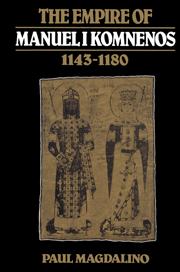Book contents
- Frontmatter
- Contents
- List of maps
- Preface and acknowledgements
- Note on transliteration and citation
- List of abbreviations
- 1 The empire, c. 1150
- 2 The heartland of the Comnenian empire
- Genealogical tables
- Introduction Problems and sources
- 1 The Comnenian empire between East and West
- 2 Constantinople and the provinces
- 3 The Comnenian system
- 4 Government
- 5 The guardians of Orthodoxy
- 6 The emperor and his image
- Epilogue
- Appendix 1 The poems of ‘Manganeios Prodromos’
- Appendix 2 Lay officials in synodal lists of the Comnenian period
- Appendix 3 Magnate ‘patrons’ under Manuel named in verse collections
- Bibliography
- Index
5 - The guardians of Orthodoxy
Published online by Cambridge University Press: 18 December 2009
- Frontmatter
- Contents
- List of maps
- Preface and acknowledgements
- Note on transliteration and citation
- List of abbreviations
- 1 The empire, c. 1150
- 2 The heartland of the Comnenian empire
- Genealogical tables
- Introduction Problems and sources
- 1 The Comnenian empire between East and West
- 2 Constantinople and the provinces
- 3 The Comnenian system
- 4 Government
- 5 The guardians of Orthodoxy
- 6 The emperor and his image
- Epilogue
- Appendix 1 The poems of ‘Manganeios Prodromos’
- Appendix 2 Lay officials in synodal lists of the Comnenian period
- Appendix 3 Magnate ‘patrons’ under Manuel named in verse collections
- Bibliography
- Index
Summary
The most enduring legacy of Byzantium is the Orthodox Church, and Orthodoxy is deservedly regarded as the essence of Byzantine civilisation. In its purest form, Orthodoxy was defined by the writings of the Church Fathers, the decrees of the Seven Ecumenical Councils, and the Synodikon of Orthodoxy, the list of heresies and heretics condemned by the Synod of Constantinople after the Seventh Ecumenical Council of 787. As such, Orthodoxy was a system of extremely complex and subtle metaphysical doctrines about the nature of the Trinity and Christ, and made no intellectual or moral concessions to the ordinary believer. But Orthodoxy survived the theological controversies that had given birth to it, and the collapse of the political structure which enforced it, because it was more than a system of beliefs: it was a way of life, a ‘feeling at home’, as Beck has described it, the sum of everything that distinguished ‘us’ from ‘them’. Its most vital expression for the ordinary believer was the Divine Liturgy, and its most potent symbol was the Holy Icon. The Feast of Orthodoxy, the second Sunday in Lent, commemorated the local Synod of Constantinople which, in 843, finally restored the veneration of holy icons of Christ and the saints. Thus, by the twelfth century, the name of Orthodoxy was associated with the memory of a relatively recent, local event. It was also associated with the most mechanical acts and familiar objects of popular religion.
- Type
- Chapter
- Information
- The Empire of Manuel I Komnenos, 1143–1180 , pp. 316 - 412Publisher: Cambridge University PressPrint publication year: 1993



